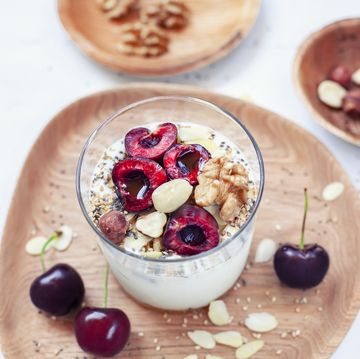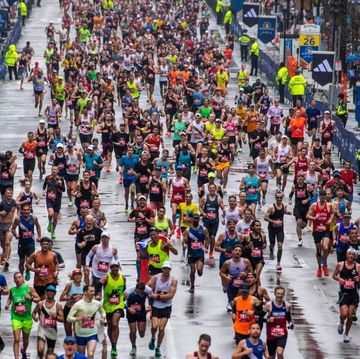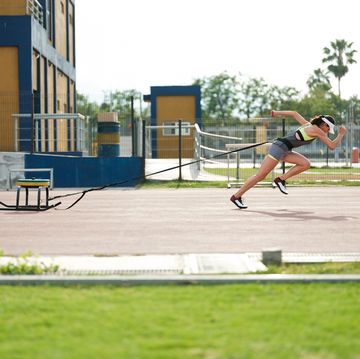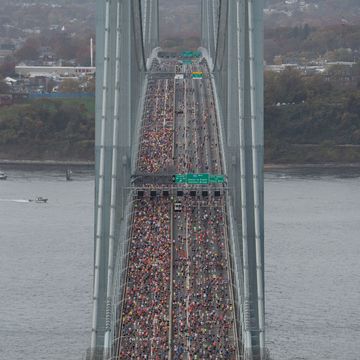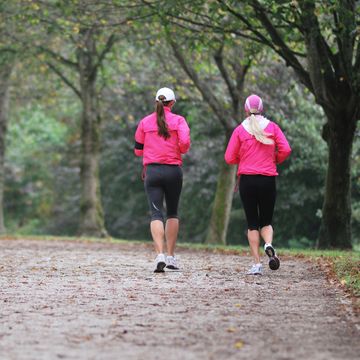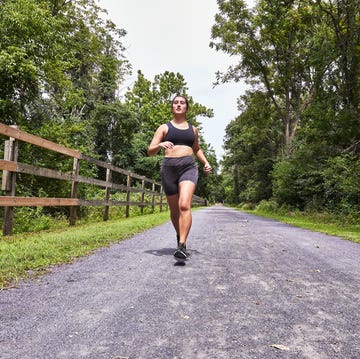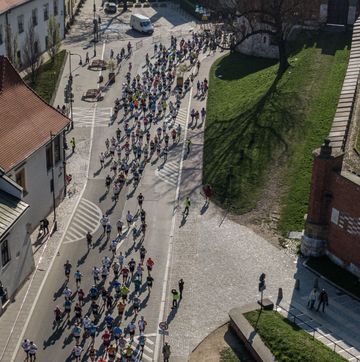Some of the world's best track athletes recently went to the Bahamas to compete in the first IAAF World Relay Championships. The resounding feedback from the runners? Competition suddenly became more meaningful--and more fun--when it was shared with a team.
"It's so thrilling to see the look in a teammate's eyes as they come toward you at the end of their leg and you can see that they're giving 100 percent," wrote Katie Mackey, a member of the relay team that came in second and set the American 4×1500m record. "It fires me up and makes me excited to be out there."
Relays aren't increasing in popularity just among the elite crowd--more runners are teaming up on the roads, too. While statistics haven't been calculated, Running USA says relay races have been growing in participation over the past decade. Race directors concur. Tanner Bell, president and co-founder of the Ragnar Relay Series, has seen participation in Ragnar races increase from 264 runners in 2004 to more than 100,000 across the country today. Similarly, Hood to Coast had fewer than 100 participants when the race started 32 years ago and now has more than 13,000--with thousands of hopefuls on the waiting list. From simple two-person, half marathon relays to pulling all-nighters with a team of 12 over a 200-mile course, the team concept is on the rise.
Jeff Hines, 53, of York, Pennsylvania, has been running relay races with dozens of Bucknell University alumni since the early 1990s. Hines and his team have completed eight relays and won nearly as many, including four consecutive years in first place at the American Odyssey Relay, from 2009-2012.
"For some of our guys, a regular road race is like 'been there, done that,'" says Hines, who has completed Hood to Coast twice. "[With relays], you're running for a team and that adds a whole different dimension."
And that added dimension is what's making relay races so attractive to so many different segments of the running population.
Wesley Ng-A-Fook, a 35-year-old runner from Miami, has completed everything from 5Ks to an Ironman and appreciates a PR just as much as the next runner. But scheduling relay races the past two years was a way to take a stab at setting goals that aren't merely individual in nature.
"I didn't look at it as a race so much as another way to go running with friends," Ng-A-Fook says. He ran the Palm Beaches Marathon Relay in 2012 and 2013.
Frankie Ruiz, chief running officer at Life Time Fitness and co-founder of the Life Time Miami Marathon and Half Marathon, agrees that "social runs" are becoming increasingly popular, even among serious and competitive athletes.
"[Relays] help people form a bond--not just a 'like' or a friend request on Facebook," Ruiz says.
Late last year, GO! St. Louis announced it would host the inaugural KT82 Trail Relay, an 82-mile course along the Katy Trail, the country's longest rail trail, this August. The local nonprofit already has a 14-year-old marathon relay, which started with just 40 teams and sold out this year at a record 650 teams. But after Missouri was named the best trail state by American Trails in 2013, Nancy Lieberman, president of GO! St. Louis, met with Missouri Governor Jay Nixon to figure out a way to promote the state's trails and outdoor fitness. The KT82 Trail Relay was born.
"When we started [with the marathon relay], our idea was that initially the relay allowed people to do a 10K. We then found that people love the whole team aspect," Lieberman says. "They love creating a name, recruiting friends, family and co-workers, and training together. It's a whole different experience for runners."
This year's KT82 lottery was capped at 200 teams, because organizers were unsure of the interest they'd receive in the race's first year. More than 400 teams entered.
"The buzz was tremendous," Lieberman says, adding that they will assess whether or not to increase the number of teams for next year.
Prepping for Team Competition
For competitive runners, relays offer a new dimension in strategy. Instead focusing on one person's fitness and ability level, the group has to create a winning collection of everybody's talent.
"We're always looking for challenges," says Bill Ling, 26, of Clementon, New Jersey, of his relay teams. He was part of a six-person team for the Reach the Beach Relay in 2013 and Ragnar Cape Cod in 2014--half the usual 12-person roster. Why? Because they knew they could win with 12 team members. Running with six gave them an ultra-style challenge. And they won both relays.
"A lot of our runners are former college athletes and Boston Marathon qualifiers," he says. "You're not going to go out and do something you know you can already do. You want to push the limits."
Training for these races can also add variety to the routine. Racing back-to-back legs in a condensed window of time, fueling between them and recovering in a cramped van with six other people requires a different kind of preparation.
"The toughest part about training is not being able to replicate how difficult it is to run hard three times in a very short period of time," says Luke Meyer, whose team, Gleukos Fast Fuelers, won the Hood to Coast Relay in 2006, Meyer's first event of that type. "Realistically, not many people are going to go out on a Saturday and do a hard workout at 9 a.m., another at 3 p.m. and another at 9 p.m."
Meyer's training advice isn't all that different from what you'd apply for a traditional race: Study the course terrain and prepare for it. When he competes at Hood to Coast this year, he's taking the 5.67-mile leg down the face of Mount Hood, so he's callousing his quads to prepare for the downhill pounding.
But don't neglect the psychological preparation, either, says Jerry Alexander, coach at Georgetown Running Club in Washington, D.C. Usually when runners sign up for a relay, they're already fit from training for other competition--but mentally they'll probably need to switch gears. Unless you're heading to the same race with the same team each year, a PR isn't waiting for you.
"Look at [a relay] as a fun thing," Alexander says. "You approach it in that spirit. As long as you get yourself in the right frame of mind to embrace the challenge, you can do it."
Other sage advice from relay veterans includes paying a bit more attention to fueling. Nutrition and recovery between legs of the event are key to prevent dehydration, muscle cramping and fatigue that can ruin what's supposed to be a fun race. Rebecca Scritchfield, founder of Capitol Nutrition in Washington, D.C., says that the time spent in the van is critical to preparing for the next relay segment. Stretch after each run and walk for another 10 minutes to prevent soreness, she says.
"Choose a recovery snack that's hydrating and rich in electrolytes and carbohydrates," Scritchfield adds, suggesting old standbys like chocolate milk, or water plus a turkey and cheese sandwich.
The most critical hurdle relay teams must overcome? Making sure everybody is healthy enough to get to the starting line. Hines recommends having a roster of 20 people who are interested in participating. As the race nears, narrow the list to the best group of six or 12 (depending on how many people are required).
"It's inevitable that a couple of guys overtrain and injure themselves," he says.
Meyer's teams have finished three of their relays--Hood to Coast, 100on100 and Reach the Beach--in the top three. His secret to creating a competitive team? While fast runners matter, they aren't the whole story. Pick people you like and won't mind getting cozy with--even during potentially stressful times--for a couple of days.
"Have people you know, who will run tough when they're tired," he says. "But it's also great to have people who you really enjoy running with and get along with really well."
Run, Eat, Rest, Repeat
Rebecca Scritchfield, who works with athletes at Capitol Nutrition in Washington, D.C., offers four quick tips for runners who decide to take one for the team:
- Prefuel one hour before each leg of the race and hydrate throughout.
- Avoid alcohol and caffeine. Both can contribute to dehydration and disrupt your rest time.
- Pack a sleeping bag, pillow and comfortable clothes for your rest times. Even if you don't fall asleep, some quiet downtime is rejuvenating.
- Think portability when it comes to packing meals and snacks. Dried fruits, dried cereals and granola bars are convenient, easy-to-digest snacks to have on hand. Bananas are rich in potassium. Other non-perishable items that are good on the road are bagels, and peanut butter and jelly sandwiches.
Relays: Big and Small
RAGNAR RELAY SERIES
Fifteen races nationwide, throughout the year.
Number of participants in 2014: 100,000+
DECELLE MEMORIAL LAKE TAHOE RELAY
June 14, 2014
72.2 miles around Lake Tahoe.
Number of participants in 2014: 840
100ON100
Aug. 16, 2014
100 miles through the heart of Vermont.
Number of participants in 2014: 1,000+
HOOD TO COAST RELAY
Aug. 22-23, 2014
199-mile race from Mount Hood to Seaside, Oregon.
Number of participants in 2014: 12,600
KT82 TRAIL RELAY
Aug. 30, 2014
82-mile trail run in Hermann, Missouri.
Number of participants in 2014: 1,200
BLUE RIDGE RELAY
Sept. 5-6, 2014
208 miles through the Blue Ridge and Black mountains of Virginia and North Carolina.
Number of participants expected in 2014: 1,500
REACH THE BEACH RELAY
Sept. 12-13, 2014
200 miles from Cannon to Hampton Beach, New Hampshire.
Number of participants in 2013: 5,600+
TUNA RUN 200
Oct. 10-11, 2014
200 miles from Raleigh to Atlantic Beach, North Carolina, featuring beer and freshly cooked tuna at the finish line.
Number of participants in 2014: 900
AMERICAN ODYSSEY RELAY
May 1-2, 2015
100 miles from Gettysburg, Pennsylvania, to Washington, D.C., passing historical landmarks along the way.
Number of participants in 2014: 1,700
MARKET TO MARKET RELAY SERIES
Three different races in Iowa, Ohio and Nebraska, each about 75 miles.
Number of participants in 2014: 7,000 for all three races





